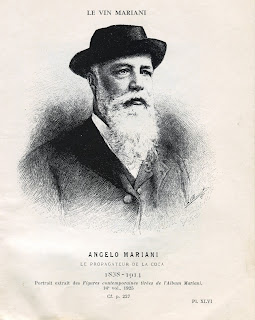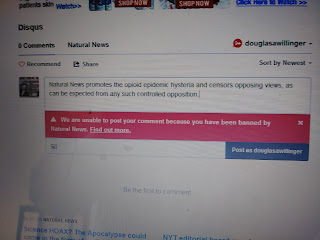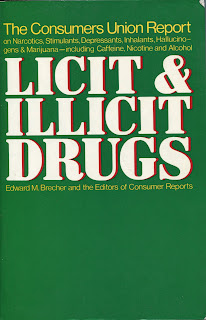Vin Mariani U.S. Penetration
Angelo Francois Mariani b. December 17, 1838 - d. April 1, 1914
http://alcoholanddrugshistorysociety.files.wordpress.com/2010/11/shad-23-1-smith1.pdf
Perhaps the best way to explain Mariani’s success, however, is the examination of Mariani and Company’s promotional materials and published consumer responses in the United States from 1886 to 1910. It seems clear that Mariani’s wine, and its many imitators, were quite popular in the United States during these years.
Actual business records of the company do not seem to exist, but at least one unique source exists: The Efficacy of Coca Erythroxylon: Notes and Comments by Prominent Physicians, a Mariani pamphlet published in 1888 and apparently distributed as promotional material. Its contents include published letters from numerous doctors across the United States praising Mariani wine. 24
Of course, this data is not as reliable as say, sales figures, and certainly there could be letters received by the company that were unpublished. However, this evidence deserves consideration. There is no doubt Mariani’s company printed the pamphlet to help sell its product. On the other hand, given the randomness of the locations of the letter writers and the diverse numbers from those particular locations, it would be hard to conclude that the company simply made up the data to sell the product. Therefore, it is quite possible to treat this evidence like a primitive form of consumer research or polling data.
Thirty-one states and the District of Columbia were represented in the pamphlet, clearly indicating a nationwide distribution system. Roughly 300, or over a quarter of these letters, came from New York State. The second most represented state is Pennsylvania with about 10% of the total. Coming in third is Massachusetts with roughly 6% of the total. Ohio followed with about 5%. 25
One interesting aspect of the distribution of these letters is their concentration in some of the most heavily industrialized parts of the country. Here, Spillane and Gootenberg’s recognition of coca/cocaine as being an aspect of modern society, and a way to cope with it, rings true.
According to U.S. Census statistics New York, the state with the most letters, was the most industrially developed state in the union in 1890, with 65,840 manufacturing establishments, and 752,066 wage earners.26
Pennsylvania had 39,339 manufacturing establishments and an average number of 570,393 wage earners.27 Massachusetts and Ohio also had high levels of industrialization with 26,923 manufacturers and 447,270 wage earners in Massachusetts and 28,673 establishments and 292,982 wage workers in Ohio.28
Although those four states were the leaders, it is important to note that the wine was present in all regions of the country.
All the Border States of the near southern United States, Missouri, Kentucky, Maryland, and Delaware (combined about 10% of total letters) had doctors who sent the company letters.29
The South is represented by Alabama, Georgia, Florida, Arkansas, Mississippi, Tennessee, Virginia, South Carolina, and Louisiana (about 8%).
The Midwest represented by Ohio, Michigan, Illinois, Indiana, Minnesota, and Wisconsin (about 22%).
The West is the smallest by proportion, represented by Nebraska, Colorado, Utah, Oregon, and California (5%).
A little over half then (55%) of the correspondence is from the heavily industrialized Northeast: New York, Pennsylvania, New Jersey, Connecticut, New Hampshire, Massachusetts, Maine, Rhode Island, and the District of Columbia.30
The lowest levels of penetration are in the west, where levels of industrialization were low: Colorado, Utah, Oregon, and California combined for 11,495 manufacturing establishments and 108, 821 wage earners, only a fraction of just one state in the Northeast, like New York.31 The numbers of imitators spawned can also measure Vin Mariani’s success.
The Druggists Circular Price List of Drugs” published in April, 1903, lists 27 wine-medicines, out of over 100, that have the word coca in their name. The number increases to almost half if one counts the appearance of the word cocoa (the terms were often confused, however one cannot discount the possibility that cocoa and wine were mixed).32
There are also 24 total listings with “Vin,” “Vinum,” and “Vinegar,” in the name, showing the presence of many other wine-medicines.
Vin Mariani also appears to be affordable; it is listed at $1.75 a bottle.33
In 1910, the price decreased to $ 1.00.34
Who consumed Vin Mariani?
The price range of $1.00 to $1.75 probably fit the average wage of $543 a year in 1902. It is likely that factory workers making $61.20 a week (on average), or $3,182 a year, or clerks making an average of $1,037 a year, could consume more than low skilled workers or domestics making $501 and $270 a year respectively.35
The price of the wine also compared favorably to that of liquor at $1.00 a quart in 1902, and other
wines priced at $5.00 for 12 quarts.36 Vin Mariani consumers were for the most part, middle class, and that appears to be the audience they reached with their advertising.
http://alcoholanddrugshistorysociety.files.wordpress.com/2010/11/shad-23-1-smith1.pdf
Perhaps the best way to explain Mariani’s success, however, is the examination of Mariani and Company’s promotional materials and published consumer responses in the United States from 1886 to 1910. It seems clear that Mariani’s wine, and its many imitators, were quite popular in the United States during these years.
Actual business records of the company do not seem to exist, but at least one unique source exists: The Efficacy of Coca Erythroxylon: Notes and Comments by Prominent Physicians, a Mariani pamphlet published in 1888 and apparently distributed as promotional material. Its contents include published letters from numerous doctors across the United States praising Mariani wine. 24
Of course, this data is not as reliable as say, sales figures, and certainly there could be letters received by the company that were unpublished. However, this evidence deserves consideration. There is no doubt Mariani’s company printed the pamphlet to help sell its product. On the other hand, given the randomness of the locations of the letter writers and the diverse numbers from those particular locations, it would be hard to conclude that the company simply made up the data to sell the product. Therefore, it is quite possible to treat this evidence like a primitive form of consumer research or polling data.
Thirty-one states and the District of Columbia were represented in the pamphlet, clearly indicating a nationwide distribution system. Roughly 300, or over a quarter of these letters, came from New York State. The second most represented state is Pennsylvania with about 10% of the total. Coming in third is Massachusetts with roughly 6% of the total. Ohio followed with about 5%. 25
One interesting aspect of the distribution of these letters is their concentration in some of the most heavily industrialized parts of the country. Here, Spillane and Gootenberg’s recognition of coca/cocaine as being an aspect of modern society, and a way to cope with it, rings true.
According to U.S. Census statistics New York, the state with the most letters, was the most industrially developed state in the union in 1890, with 65,840 manufacturing establishments, and 752,066 wage earners.26
Pennsylvania had 39,339 manufacturing establishments and an average number of 570,393 wage earners.27 Massachusetts and Ohio also had high levels of industrialization with 26,923 manufacturers and 447,270 wage earners in Massachusetts and 28,673 establishments and 292,982 wage workers in Ohio.28
Although those four states were the leaders, it is important to note that the wine was present in all regions of the country.
All the Border States of the near southern United States, Missouri, Kentucky, Maryland, and Delaware (combined about 10% of total letters) had doctors who sent the company letters.29
The South is represented by Alabama, Georgia, Florida, Arkansas, Mississippi, Tennessee, Virginia, South Carolina, and Louisiana (about 8%).
The Midwest represented by Ohio, Michigan, Illinois, Indiana, Minnesota, and Wisconsin (about 22%).
The West is the smallest by proportion, represented by Nebraska, Colorado, Utah, Oregon, and California (5%).
A little over half then (55%) of the correspondence is from the heavily industrialized Northeast: New York, Pennsylvania, New Jersey, Connecticut, New Hampshire, Massachusetts, Maine, Rhode Island, and the District of Columbia.30
The lowest levels of penetration are in the west, where levels of industrialization were low: Colorado, Utah, Oregon, and California combined for 11,495 manufacturing establishments and 108, 821 wage earners, only a fraction of just one state in the Northeast, like New York.31 The numbers of imitators spawned can also measure Vin Mariani’s success.
The Druggists Circular Price List of Drugs” published in April, 1903, lists 27 wine-medicines, out of over 100, that have the word coca in their name. The number increases to almost half if one counts the appearance of the word cocoa (the terms were often confused, however one cannot discount the possibility that cocoa and wine were mixed).32
There are also 24 total listings with “Vin,” “Vinum,” and “Vinegar,” in the name, showing the presence of many other wine-medicines.
Vin Mariani also appears to be affordable; it is listed at $1.75 a bottle.33
In 1910, the price decreased to $ 1.00.34
Who consumed Vin Mariani?
The price range of $1.00 to $1.75 probably fit the average wage of $543 a year in 1902. It is likely that factory workers making $61.20 a week (on average), or $3,182 a year, or clerks making an average of $1,037 a year, could consume more than low skilled workers or domestics making $501 and $270 a year respectively.35
The price of the wine also compared favorably to that of liquor at $1.00 a quart in 1902, and other
wines priced at $5.00 for 12 quarts.36 Vin Mariani consumers were for the most part, middle class, and that appears to be the audience they reached with their advertising.




Comments
Post a Comment